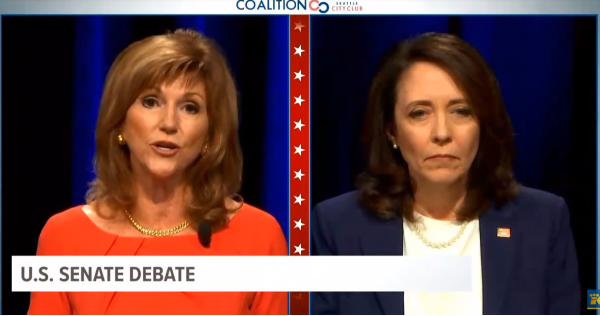
UPDATED, 10-9 @ 12:45 P.M. — Monday’s debate between incumbent U.S. Senator Maria Cantwell and GOP challenger Susan Hutchison concluded with a few minutes on the gun issue, and their responses underscore the deep divide between the gun control philosophy of ever-increasing restrictions and common sense approaches that protect the rights of law-abiding gun owners, including women.
Not mentioned during the debate, or so far by any major news organization in the state, is the growing opposition by law enforcement to a controversial gun control initiative on the November ballot. The establishment press has almost completely ignored this significant development. On Tuesday, the Washington State Patrol Troopers Association announced its opposition to Initiative 1639, joining three other major state law enforcement groups against that measure. Both candidates took positions on the content of the initiative, without specifically referencing it.
Near the end of Monday’s debate, Cantwell, who has been a perennial supporter of gun control proposals, supported bans on bump stocks and believed that so-called “universal background checks” help prevent violent crimes.
Hutchison contended that “an 18-year old who can go to war and carry a gun should have the right as a law-abiding citizen, and under the protections of the Second Amendment, to own a gun.”
The debate, at Pacific Lutheran University south of Tacoma, was hosted by the Washington State Debate Coalition and will be followed in several days by a second debate in Spokane, the Seattle P-I.com noted.
Cantwell told the audience that gun laws should mandate that people “follow good gun safety.”
But Hutchison countered that people have the right to self-defense and that “an awful lot of these laws do hurt women.”
While one poll reportedly shows Cantwell with a comfortable lead, that could be uncomfortably eroded by two things: the way her Senate Democrat colleagues handled themselves during the contentious hearing process to confirm Brett Kavanaugh to the U.S. Supreme Court, and back west in “the other Washington,” a billionaire-backed gun control initiative that has fired up a grassroots effort among gun owners to defeat the measure next month, on what literally is a shoestring budget.
I-1639, which was only alluded to without being named in questions regarding so-called “safe storage” and raising the minimum age to purchase semiautomatic rifles in the Evergreen State, appears to have aroused the proverbial sleeping giant of Second Amendment activism that was not so evident four years ago when gun prohibitionists pushed through Initiative 594 with a $10.2 million campaign. Gun owners remember that, and many regret their lethargy. They’re determined to not let that happen again.
They have a powerful argument: Law enforcement opposes the measure. In addition to the State Troopers Association, the Washington State Law Enforcement Firearms Instructors Association, Washington State Sheriffs Association and Washington Council of Police & Sheriffs are opposed. These groups represent thousands of rank-and-file troopers, sheriff’s deputies and municipal police officers from Aberdeen to Spokane.
By no small coincidence, the Seattle Times’ Tuesday edition has a lengthy piece on I-1639, backed by the same Seattle-based gun control lobbying group. That article recognizes that the measure includes a “constellation of regulations.” Critics contend that it violates the single-subject rule for a citizen initiative.
The Times article also acknowledges that there are “components that would set Washington state apart from most states.”
“The measure would also require firearms training before a gun can be purchased,” reporter Ryan Blethen correctly notes, “a 10-day waiting period after the purchase of a gun, and add a class C felony to the books for gun owners whose firearm is accessed by a person prohibited from having a firearm. The class C felony would be the most severe in the nation for a violation of storage laws.”
Likewise, it would classify every semiautomatic rifle in the state, including popular big game hunting rifles and smallbore rifles used for training, target and recreational shooting, and small game hunting, as “semiautomatic assault rifles.”
The Times story also revealed that there are already “43 gun-related laws or regulations” in Washington state. Opponents of I-1639 contend that’s more than enough, and that the earlier gun control measure did not live up to its promise when passed in 2014, because the high-profile shooting that is used to promote I-1639 happened 18 months after I-594 took effect. The killer passed a background check.